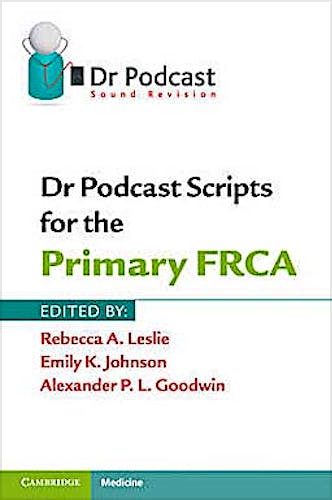

No hay productos en el carrito



Dr Poscast Scripts for the Primary Frca
Leslie, R. — Johnson, E. — Goodwin, A.
1ª Edición Abril 2011
Inglés
Tapa blanda
352 pags
680 gr
16 x 23 x 2 cm
ISBN 9781107401013
Editorial CAMBRIDGE
LIBRO IMPRESO
-5%
73,16 €69,50 €IVA incluido
70,35 €66,83 €IVA no incluido
Recíbelo en un plazo de
2 - 3 semanas
Description
Dr Podcast (www.dr-podcast.com) is a great way to revise for the FRCA exams and has been met with widespread enthusiasm from candidates. It provides podcasts of questions and model answers with no redundant material. Dr Podcast scripts are now available in print format. Containing the scripts of all 90 individual podcasts from the Dr Podcast Primary FRCA collection, they also include diagrams the reader can draw to explain their answers. They cover the entire syllabus for the Primary FRCA, allowing the readers to experience the style of the questions likely to be asked and providing tips on how to excel in the exam. Each podcast is written by a successful candidate who has insight and experience of the exam, and all material has been reviewed by experienced consultants with detailed knowledge of the educational standards. For those preparing for the Primary FRCA exams, Dr Podcast scripts are a must.
• Provides the perfect answer for each question, providing the reader with a model for excelling in the exam • Includes simple diagrams that the reader can reproduce in their viva to demonstrate their understanding • Written by successful exam candidates with input from experienced consultants, questions and model answers are designed to match the content and the standards expected in the exam
Contents
Preface; Part I. Physiology: Section 1. Respiratory Physiology: 1. Lung volumes;
2. Respiratory compliance; 3. Ventilation, perfusion and dead space; 4. Alveolar
gas equation and shunt; 5. Hypoxic pulmonary vasoconstriction; 6. Oxy-haemoglobin
dissociation curve; 7. Altitude physiology; Section 2. Cardiovascular Physiology:
8. Cardiac cycle; 9. Coronary circulation; 10. Pacemaker cells; 11. Valsalva
manoeuvre; 12. Exercise physiology; Section 3. Physiology of the Central, Peripheral
and Autonomic Nervous System: 13. Cerebral circulation; 14. CSF; 15. Blood brain
barrier; 16. Action potentials; 17. Reflex arc; 18. Spinal cord; 19. Autonomic
nervous system and adrenergic receptors; Section 4. Physiology of the Neuromuscular
Junction: 20. Neuromuscular junction; 21. Muscle physiology; Section 5. Fluids
and Renal Physiology: 22. Fluid balance; 23. Acid-base physiology; 24. Renal
physiology; Section 6. Liver and Endocrine Physiology: 25. Glucose and metabolism;
26. Pituitary and endocrine function; 27. Thyroid gland; 28. Adrenals; 29. Starvation
and stress response; 30. Liver and clotting; 31. Proteins and haemoglobin; Section
7. Immunology: 32. Immunology; Part II. Pharmacology: Section 8. Pharmacological
Principles: 33. Pharmacokinetics; 34. Drug action and receptors; 35. Drug interactions;
36. Agonists and antagonists; 37. Isomers; Section 9. Intravenous Induction
Agents: 38. Propofol and thiopentone; 39. Etomidate and ketamine; Section 10.
Inhalational Anaesthetic Agents: 40. Inhalational agents; 41. MAC; 42. Nitrous
oxide; Section 11. Neuromuscular Blocking Agents and Anticholinesterases: 43.
Neuromuscular blocking agents; 44. Suxamethonium; 45. Anticholinesterases; Section
12. Local Anaesthetics: 46. Local anaesthetics; Section 13. Analgesic Agents:
47. Analgesic agents; Section 14. Drugs Acting on the Central Nervous System:
48. Anti-convulsant agents; 49. Benzodiazepines; Section 15. Drugs Acting on
the Cardiovascular System: 50. Anti-hypertensive agents; 51. Anti-arrhythmic
agents; 52. Inotropes; Section 16. Drugs Acting on the Gastrointestinal and
Endocrine Systems: 53. Drugs acting on the GI tract; 54. Anti-emetic agents;
55. Hypoglycaemic agents; Section 17. Antibiotics: 56. Antibiotics; Section
18. Anticoagulants: 57. Anticoagulants; Section 19. Statistics: 58. Statistical
analysis; 59. Statistical data; Part III. Physics: Section 20. Units of Measurement:
60. SI units; Section 21. Biological Signals and their Measurement: 61. Biological
signals; 62. Electrocardiogram; 63. Neuromuscular monitoring; Section 22. Gas
Flow and its Measurement: 64. Gas laws; 65. Flow; 66. Measurement of gas volume
and flow; Section 23. Gas Supply and Delivery: 67. Cylinders and gas supply;
68. Breathing systems; 69. Vaporisers; 70. Soda lime and carbon dioxide absorption;
71. Scavenging; Section 24. Measurement of Oxygen, Carbon Dioxide and Anaesthetic
Agents: 72. Measurement of anaesthetic agents; 73. Oxygen measurement; 74. Pulse
oximetry; 75. pH and carbon dioxide measurement; 76. Capnography; Section 25.
Temperature and Humidification: 77. Heat loss; 78. Temperature and its measurement;
79. Humidification; Section 26. Pressure Measurement: 80. Pressure measurement;
81. Blood pressure measurement; 82. Resonance and damping; 83. Intracranial
pressure measurement; 84. Cardiac output measurement; Section 27. Electricity:
85. Electricity; 86. Electrical safety; Section 28. Equipment: 87. Defibrillators;
88. Lasers and diathermy; 89. Ultrasound; Index.
Reviews
'These recordings are fantastic … best thing I've discovered since my
hunt for revision material started! Well done … Keep it up!' Dr Podcast
user
'I found the primary podcasts immensely useful, they really did help me pass the primary exam last week. Looking forward to the final podcasts.' Dr Podcast user
'The podcasts were brilliant and the content was excellent. Thank you very much.' Dr Podcast user
Contributors
Emily K. Johnson, Rebecca A. Leslie, Joy M. Sanders, Caroline S. G. Janes, Caroline
V. Sampson, Sarah F. Bell, Natasha A. Joshi, Yvette G. M. Coldicott, Dana L.
Kelly, Archana Panickar, Adrian Clarke, Henry Murdoch
© 2025 Axón Librería S.L.
2.149.0